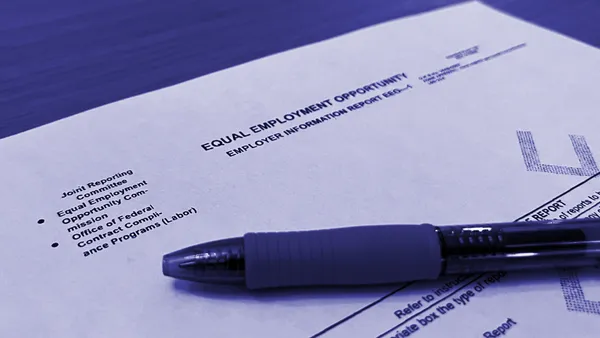Dive Brief:
- Employers must record certain commuting injuries, the Occupational Safety and Health Administration (OSHA) said in a Jan. 4 letter, representing a shift in the agency's interpretation of tasks that are a "condition of employment."
- The Letter of Interpretation explained that an employee required to return to the workplace outside of his normal commute is engaged in a work activity as a "condition of employment," so a resulting injury "is work-related and must be recorded on the OSHA 300 Log."
- Although the LOI did not expand employers' reporting obligations under 29 CFR 1904.5(b)(6), it "will cause more cases to be recorded," according to workplace safety and employment attorney J. Micah Dickie.
Dive Insight:
OSHA's letter came in response to an employer inquiry about OSHA's regulatory position on the following scenario:
As part of their normal workday, an employee commutes in his personally-owned vehicle from home to the workplace. At the end of his 8-hour work-shift, the employee commutes from the workplace to his home. Later that same day, there is an emergency at the workplace, and the employee's supervisor calls him to return to work to assist with resolving the emergency. The employee starts driving back to the workplace, but is involved in a motor vehicle accident with another car. The accident results in the employee sustaining an injury and hospitalization.
In response, OSHA reframed the scenario in a question: Is the employee's injury resulting from the accident during the second trip back to the workplace a recordable injury?
An employee's normal commute — that is, travel from home to work or from work to home — ends once the employee arrives at work or at home, Dickie of Fisher Phillips explained. An injury sustained during an employee's normal commute is not recordable on the OSHA 300 Log, since, as the LOI stated, "...the employee's normal commute to and from work represents a non-work-related activity that is within the personal control of the employee."
However, in an emergent circumstance, such as the scenario spelled out in the LOI, where an employer calls an employee back to the workplace, and the employee sustains an injury or illness during that non-standard commute, while "traveling in the interest of the employer," the injury or illness "meets the recording criteria for that 300 Log," said Dickie.
A high injury and illness rate reflected on the OSHA 300 can be a powerful player in a unionizing effort, and could subject an employer to more comprehensive reporting on form 300A, said Dickie. "A lot of third party organizations have FOIA'd …those documents in the past to …drum up support for union activity," explaining that OSHA may also use logs to select workplaces for site visits. Multiple entries to a 300 Log, "can also be used to drive up workers' comp rates, so this is actually bad for employers." They're incentivized to accurately report things, he said, but they don't want to over report.
Offering another example, Dickie said if an employee on the way to work is diverted by the employer to pick up a part from a supplier, the employee is, from that point, engaged in a work activity in the interest of the employer, and what had been a normal commute becomes a condition of employment. In that scenario, an employee injury would be recordable.
Similarly, the LOI explained that "since the employee was required to return to the workplace outside of his normal commute, the employee was engaged in a work activity 'in the interest of the employer,' and was traveling as a 'condition of employment,'" so a resulting injury or illness "is work-related and must be recorded on the OSHA 300 Log."
"Most employers would think 'No, this is not recordable.' Unfortunately, this letter says it is, [and] it really expands the notion of what is the condition of employment," he said, and continued, "While this is an expansion of what will be considered a condition of employment, or 'in the interest of the employer,' it's also a logical progression of OSHA's reading of the standard."
The agency signaled a move in this direction in a March 2021 LOI. In that letter, injuries sustained by an employee between home and the first of what would be several commutes for customer visits scheduled that day, were determined to be not work-related, so not necessary to record on the OSHA 300 Log.
As noted on the agency's website, Letters of Interpretation "cannot create additional employer obligations," and Dickie reminded employers these letters don't have the force of law and are not recognized as a defense against an OSHA citation — "only the regulation, 29 CFR 1904.5(b)(6). That's the standard." Still, he predicted, this letter will cause more cases to be recorded.












